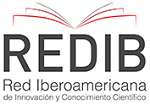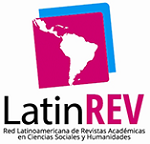Structural model of correlation between healthy practices and strategy, in health institutions of the Colombian-Venezuelan border.
DOI:
https://doi.org/10.15649/2346030X.699Keywords:
Organizational strategies, healthy practices, structural model, health institutions, border.Abstract
In health institutions management is necessary under the perspective of healthy practices, in order to start favorably in work and organizational efficiency, taking into account the workloads and work stress to which hospital workers are subjected. In these terms, the objective of the research was to establish a structural model to determine the relationship between organizational strategies and healthy practices in the Lending Institutions of Health (IPS) of the Colombian-Venezuelan border area. The methodology was quantitative, correlational and confirmatory factor analysis, applied to a sample of 50 institutions. The phases of the analysis were: field work to identify and describe healthy strategies and practices in the companies under study; the identification of the associated factors through exploratory factor analysis; Confirmatory analysis and contrast of results with theoretical conceptualization. The results indicate that the variables planning, human resource and environment, have no impact or associated with the strategy, while the varied stakeholders has a high relationship. It is concluded that the first order factors of the structural model are made up of observable variables with statistically significant factor loads.
References
H. Mintzberg, “La estructuración de las organizaciones”. Barcelona: Ariel. 1987.
J. Pfeffer y R. Sutton, “The knowing-doing gap: How smart companies turn knowledge into action”, Estados Unidos: Harvard Business School Press. 1999.
Corporación de Salud del Estado Táchira. “Red asistencial”. 2018. [En Linea]. Disponible en: http://corposaludtachira.gob.ve/?page_id=587. Consultado, noviembre, 2018.
M. Porter, “Estrategia competitiva”. Michigan: Cesca. 1981.
L. Gutiérrez, “Paradigmas cuantitativo y cualitativo en la investigación socio-educativa: proyección y reflexiones”. Paradigma, 14(1y2), 7-25.2017.
N. Rueda-Archila, D. Romero-Perez y C.S. Gómez-Vergel, “Factores que inciden en la aplicación de números racionales en educación básica secundaria en una zona de frontera”, Aibi Revista investig. adm. ing. 7 18, 2019.
J. Hair, R. Anderson, R. Tatham y W. Black, W. “Análisis Multivariante”, Madrid: Prentice Hall, 1999.
M. Salanova, “Organizaciones saludables y desarrollo de recursos humanos”, Revista de trabajo y seguridad social, 2 (1), 301-303. 2008.
M. Ortega, M. Vergel y J. Martínez, J. “Validity of Microrubri”, instrument to measure the development of competences in mathematics, 2018.
K. Patiño, C. Vargas y D. Moreno, “Pizarra interactiva y matemáticas”. Revista covalente. 1 (1) 33-36, 2019.
J.J. Pérez, “Lectura y aprendizaje gestión. Idea: revista de educación de Castilla-La Mancha”, Toledo, año 1, n. 2, septiembre; p. 126-130. 2012.
L. Pilonieta, J. Martínez y M. Vergel, “Lineamientos de enseñanza a estudiantes con hipoacusia: una acción creativa que transciende la educación inclusiva”, Bogotá: Ecoe-Ediciones, 2019.
Y. Duarte, J.V. Sanchez-framk y C. Gómez, “El trabajo colaborativo en las competencias económicas y financieras en estudiantes del Instituto Agrícola Región del Catatumbo-Colombia”, Revista covalente. 1 (1), 37-41, 2019.
A. Rusilowati, L. Kurniawati, S. Nugroho y A. Widiyatmoko, “Developing an Instrument of Scientific Literacy Assessment on the Cycle Theme International Journal of Environmental & Science Education”, 11 5719, 2016.
D. Belsley, E. Kuh, E. y R. Welsch, “Regression diagnostic: Identifiying influential data and sources of collinearity”, Hoboken, New Jersey: John Wiley, 2004.
C. Lowry y P. Hanges, “What is the Healthy Organization? Organizational Climate and Diversity Assessment: A Research Partnership”, Libraries and the Academy, 8(1), 20-35, 2008.
Y. Bukchin y T. Raviv, “Constraint programming for solving various assembly line balancing problems”, El Sevier, 2017.
M. Rodríguez-Cancio,”Materiales y recursos Manual de usos prácticos para el docente”, Vigo. Ed: Ideas Propias, 2011.
M. Jáimez, y F. Bretones, “Towards a healthy organisation model. Is-Guc”, The Journal of Industrial Relations & Human Resource, Vol. 13, No. 3, pp. 7-26, 2011.
R. Kaplan y D. Norton “Mapas Estratégicos convirtiendo los activos intangibles en resultados tangibles”, España: Harvard Business School Publishing Corporation, 2004.
A. Boomsma, “Reporting Analyses of covariance structures: Structural Equation modeling”, A multidisciplinary journal, Vol. 7, No. 3, pp. 461-483, 2006.
M. Vergel-Ortega, J.F. Nieto y J. Martínez-Lozano, “Validez de instrumento para el aprendizaje creativo”, Revista Comunicaciones en Estadística, 9(2), 17-29, 2016.
doi:http://dx.doi.org/10.14483/udistrital.jour.RC.2015. 23.a2
M. Vergel-Ortega, J. Martínez-Lozano y M. Contreras-Díaz, “Percepciones y características del espacio público y ambiente urbano entre habitantes de la ciudad de Cúcuta-Colombia”, Prospectiva, Revista de Trabajo Social e intervención social 21, 2016.
Organización Mundial De La Salud. “Salud de los Trabajadores”, 141-149. NY: Sprienger. 2015.
L. Fernández, N. Universidad, “sociedad y conocimiento”. Reflexiones para el debate, Avaliação, Campinas; Sorocaba, SP 19(3), 663-687, (nov), Universidad Nacional de Tres de Febrero, Buenos Aires, Argentina, 2014.
P. Morales, B. Urosa y A. Blanco, “Construcción de escalas de actitudes tipo Likert”, Madrid: La Muralla, 2003.
M. Páramo, B. Carrillo y M. Romero, “Propuesta y validación de un algoritmo Simulated annealing modificado para la solución de problemas de optimización”, El Sevier Doyma, 30(4), 264-270, 2014.
H. Parra-López, J.P. Rojas-Suárez y M. Vergel-Ortega, “Curricular trends in the Universidad Francisco de Paula Santander academic program offerings. Journal of Physics: Conference Series”, 1329 (1), 012013, 2019.
M. Vergel, L. Paz y J. Rojas, “Concepciones de educación a distancia y matemática financiera desde la comprensión onto histórica de sus actores”, Bogotá: UFPS-Ecoe ediciones, 2018.
D. Hosmer y S.A. Lemeshow, “goodness-of-fit test for the multiple logistic regression model”, Communications in Statistics, 10(1), 1043-1069, 2000.
M. Wilson, D. Dejoy, R. Vandenberg, H. Richardson y A. Mc- Grath, “A. Work and employee health and well-being: Test of a model of healthy work organization”, British psychological society, 77(1), 568–588, 2004.
J. Delgado, J.P. Rojas y M.Vergel-Ortega, “Geometrización de indicadores urbanos”, Estrategia pedagógica en matemáticas desde una mirada de la socioespistemología, Bogotá: ECOE Ediciones. 95-112, 2019.
Y. Li y C. Tan, “Matching business strategy and CIO characteristics: The impact on organizational performance”, Journal of Business Research, Vol. 66, No. 13, pp.248–259, 2013.
E. Claver-Cortés, E. Pertusa-Ortega y J. Molina-Azorín, “Characteristics of Organizational Structure Relating to Hybrid Competitive Strategy: Implications for Performance”, Journal of Business Research, 65, 993-, 2012.
J. Ojo, “Competitive strategy and total quality management culture in organizations”, African Research Review, Vol.1, No. 1, pp.1-15, 2008.
M.E. Stokes, C.S. Davis y G.G. Koch, “Categorical Data Analysis using the SAS System”, 2nd. Edition, SAS Institute Inc., SAS Campus Drive, Cary, North Carolina, 27513, 2000.
P. Heering y R. Wittje, “An Historical Perspective on Instruments and Experiments in Science Education”, Science & Education, 21(2), 151–155, 2012.
M. Peláez, “Dimensions of rules and their correspondence to rule-governed behavior European Journal of Behavior Analysis 14 259. 2013.
K. Moosa y A. Sajid, “Critical analysis of Six Sigma Implementation”, Total Quality Management, 21 748, 2010.
M. Li, Q. Tang, Q. Zheng, X. Xia y C. Floudas, “Rules-based heuristic approach for the U-shaped assembly line balancing problem”, El Sevier, 48, 423 - 439. 2017.
Z- Li, I. Kucukkoc y J. Mukund, “Comprehensive review and evaluation of heuristics and meta-heuristics for two-sided assembly line balancing problem”, El Sevier, 84, 146 – 161, 2017.
Downloads
Published
How to Cite
Issue
Section
Altmetrics
Downloads
License
The journal offers open access under a Creative Commons Attibution License

This work is under license Creative Commons Attribution (CC BY 4.0).











